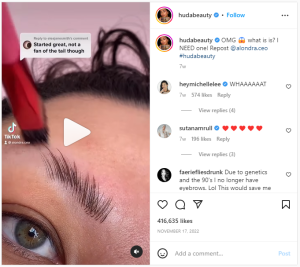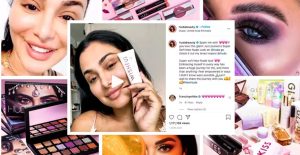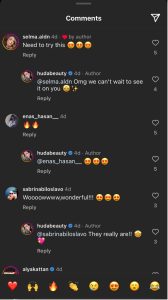80 Beyond Beauty: How Huda Kattan’s Digital Empire Redefines Fan Engagement by: Ola Elnimah
The landscape of influence and engagement in the modern networked media era has transformed dramatically, especially in the last year. It has been personified by individuals like Huda Kattan. In addition to building a strong online presence on sites like Instagram. Kattan has revolutionized audience engagement with her Huda Beauty tutorials and user-generated content. With a focus on Huda Kattan’s tutorials, this essay aims to critically examine fan and follower participation in the beauty and lifestyle domains.
Huda Kattan is a prominent figure in the beauty industry, best known for founding the cosmetics brand Huda Beauty. She launched the Huda Beauty blog in Dubai in 2010 and became well-known for her real-life personality and makeup tutorials. Together with her sisters Mona and Alya, Kattan founded Huda Beauty in 2013 after realizing the potential of her expanding online fan base. At first, the three of them concentrated on creating a line of false eyelashes. Since then, the company has grown dramatically, selling over 100 items—from lip gloss to eyeshadow palettes—and bringing in about $200 million a year. Huda Beauty was valued at $1.2 billion when the private equity firm TSG Consumer Partners purchased a minority stake in the company in 2017 (Locke, 2021).
Beyond just her brand, Kattan has a significant impact; she has almost 53 million Instagram followers and is well-known for her marketing strategy, having never paid for advertising (Locke, 2021). Her tale is one of tenacity and entrepreneurial spirit, as she turned a personal tragedy into a prosperous enterprise in the beauty sector.
The importance of audience participation in this field goes beyond simple consumption; it reflects a nuanced interaction between economic influence, community development, and empowerment. Fans interact with brands, but they also contribute to a vibrant community of shared practices, set industry standards, and shape beauty trends as they copy Kattan’s tutorials and produce their content. This phenomenon signifies a change in the way consumers engage with media personalities and goods, with significant ramifications for the beauty sector, conventional notions of beauty, and the landscape of digital culture.
Audiences’ role has evolved significantly, especially in the beauty industry, where influencers like Huda Kattan are crucial. Nowadays, audiences are more than just consumers; they take an active role in the production and distribution of content. This change is eloquently explained in the context of social media, where “social media provides opportunities for both individual users and organizations”, and “individual users can share their knowledge and experience with the wide world” pg. 4 (Kaplan & Haenlein, 2021). This shift is best represented by Huda Kattan and her Huda Beauty line. She uses social media to engage with her audience and accomplish marketing objectives like raising brand recognition and swaying customer opinions and purchase intent.
When examining influencers like Kattan, the ideas of affective economics and communicative capitalism become especially pertinent. According to Ananda et al. (2017), audiences view these influencers as more genuine and reliable than traditional celebrities or endorsers. This impression is furthered by infrequent interactions with audience members, which convey an air of sincerity and foster the illusion of a personal connection—akin to speaking with a far-off friend. Huda Kattan skillfully uses this trust to sway customer behavior by fusing sincere engagement with business objectives.
Furthermore, comprehending the dynamic between influencers such as Kattan and her followers necessitates an understanding of the notion of affective labor. Social media influencers, in contrast to traditional celebrities, frequently do not view themselves as famous in the traditional sense. Rather, they are ‘instafamous,’ a recognition that is only possible online. Her goal is to create authentic content to fulfill her primary role of inspiring and influencing. Her relationship with her audience is greatly influenced by this authenticity, which is defined by her candor, inventiveness, and immediateness. Kattan maintains close online relationships with her audience, in contrast to traditional celebrities who may interact with their fans selectively. She has a separate account on Instagram, @HudaBeauty where she frequently reposts her fans or other creators who use her products, recreate makeup looks, or simply share life hacks (Appendix A). In the digital era, audiences thrive from this type of parasocial relationship which is built on such a personal level of interaction.
With her Huda Beauty brand, Huda Kattan has amassed a devoted following that she has skillfully grown into a thriving community of consumers. The strong dynamics of fan and consumer behavior in the digital age are demonstrated by this phenomenon. According to Lyons (2018), “Kattan’s nearly 29 million Instagram followers interact with her content actively, with an average of 400,000 views and more than 3,000 comments per post”. This interaction indicates a closer bond between the consumer and the brand than is typical. Sharing memes, inspirational quotes, beauty tips, tutorials, and retweets of fans utilizing her products are all part of Kattan’s strategy to build a mutually beneficial relationship where fans contribute to the brand’s story. She has created an iconic brand and given her followers a sense of community by incorporating her genuine voice and posts, which has encouraged them to turn their fandom into consumerism.
Huda Beauty fans’ interactions with the brand are a striking example of “everyday cosplay” and performative consumption. The line between fan and consumer becomes less distinct as they imitate Kattan’s cosmetic styles, fostering a participatory culture. Devoted to Kattan, these fans participate in theatrical activities that amplify the brand’s impact and audience. On websites like Instagram, they also share their experiences and artistic interpretations, which both question and occasionally uphold conventional notions of beauty. Lyons (2018) notes that the secret to Huda Beauty’s success is Kattan’s ability to stay true to herself and genuinely engage her audience, giving her fans a sense of worth and validation. Fans can express their uniqueness and creativity through this engagement, which not only increases the brand’s visibility but also adds to the story of digital beauty culture.
Moreover, her strategy draws attention to the complex interplay in the field of fan-generated content between immaterial and material property. This interaction is reminiscent of the idea of the “immaterial psychological property” of fandom, which is emphasized in the theoretical frameworks of Henry Jenkins. In these frameworks, the emphasis is placed on affect, values of the community, and artistic self-expression within fan cultures (Kulinicheva, 2021). This translates to a distinctive fusion of material goods and the intangible but potent emotional and social ties that fans form with Huda Beauty, reflecting the dynamics seen in subcultures such as sneakerheads. Here, the immaterial components of fan interaction—” which include a common set of preferences, customs, and creative expression” pg. 2 (Kulinicheva, 2021) —have a significant influence on how products are materially consumed, enhancing our comprehension of fashion and beauty as participatory cultures.
Kattan blurs the boundaries between brand promotion and personal expression by encouraging her followers to produce content with her products. Fans turn into “craft consumers” and “fan-trepreneurs,” using their brand loyalty to carve out niches for themselves in the cosmetics sector. Lyons (2018) highlights that Huda Beauty’s growth and prominence can be attributed to this dynamic, wherein fans not only consume but also actively shape the brand’s narrative. Kattan has created a community where fans’ loyalty goes beyond consumerism, and they feel like they are a part of the ‘Huda family’ through her constant interaction with them and her acknowledgment of their contributions. This has created a special and long-lasting brand relationship.
This is attributed to her ways of shamelessly standing for what she believes, she is not an ‘industry plant’ that is afraid of losing sales or credibility. To provide a platform for the expression of beauty, Huda Kattan’s Huda Beauty brand has also challenged and occasionally reinforced conventional beauty standards. This is largely due to her willingness to share her beliefs and her outspoken nature. “I think the beauty industry is sexist,” Kattan declares, denouncing a sector that frequently minimizes women based only on their outward appearance. Her brand, which values inclusivity and representation and provides products in a variety of skin tones and deeper shades, reflects this resistance ideology. By taking what she calls a “snail’s pace” toward inclusivity, Kattan’s strategy highlights her dedication to questioning conventions and promoting a diverse and inclusive beauty industry (Butterly, 2023).
In terms of the antecedents of consumer fandom, Huda Beauty stands as a beacon for self-identity and representation. Customers utilize Huda Beauty as a platform for identity expression, seeing in Kattan’s confidence a way to mirror their unique narratives and goals. Kattan’s journey—from feeling unattractive as a child to empowering others through her brand—deepens this connection. She builds a strong connection with her followers on social media by being genuine and sharing details of her life and vulnerabilities. This relationship goes beyond simple product consumption; rather, it encourages aspirational consumption and self-discovery, turning the purchase of Huda Beauty goods into a declaration of ambition and personal development.
In Kattan’s words, “When I go on social media, sometimes I feel I can never be good-looking enough. I can never have achieved enough” (Butterly, 2023). Her openness regarding her battles with the demands of social media strikes a deep chord with her followers, creating a sincere bond. This bond is based on human experiences rather than just common interests in beauty, which highlights the impact of social media and subjective norms on behavior and perception. As Affuso, 2018 highlighted “Digital culture allows fans to perform their consumption in a multitude of ways, including Instagram pics, tweets, and haul videos. These videos open spaces for inclusive and resistant fan activity and align with the girl power and body positivity elements of contemporary culture” pg. 5.
Analyzing Huda Beauty’s social media engagement reveals a dynamic and reciprocal relationship between the brand and its audience. Appendix B is a fan’s eyebrow makeup technique from a TikTok video that was reposted on Instagram. It received hundreds of thousands of likes and helped the brand get recognition through user-generated content. This demonstrates how Huda Beauty promotes a participatory culture by elevating fan contributions in addition to sharing its content. The fan’s innovative use of Huda Beauty products is endorsed by the repost, which also inspires other followers to share their beauty experiments. This feedback loop expands the brand’s visibility and audience.
Further examination of Huda Beauty’s social media strategy is evident in Appendix C, where Huda directly responds to a fan’s comments on TikTok and creates a tutorial to go along with it. This interaction was multifaceted seeing as the fan can be seensaying “I spammed Huda beauty’s comments [about] this one lip [combination] [because] it was driving me crazy until she answered”. This illustrates that it is difficult to reach a ‘celebrity’ once they break the barriers of fame. However, Kattan’s personalized replies, addressing fans with endearing terms like “babe” and inviting them to view more content, are prime examples of affective labor. These interactions are not merely transactional; they carry an emotional value that enhances the brand’s image and fosters brand loyalty. The direct engagement with fans not only personalizes the brand experience but also encourages continuous interaction, keeping the audience engaged and emotionally invested.
A study by Mimoun et al. (2023), in an article discussing parasocial relationships, discovered a strong correlation between PSRs (parasocial relationships) and the SMI’s (social media influencers) perceived expertise, which together affects consumer behavior. This suggests that in addition to improving the brand’s image, Kattan’s interactions with her followers—which extend beyond transactional relationships to include emotional labor—also actively influence her audience’s attitudes and behaviors regarding Huda Beauty products. Therefore, Kattan’s endorsements are not only effective because of the products themselves; they also have a big impact because of the PSRs she has built and her reputation as a reliable authority in the beauty industry. The study further acknowledges that followers see “SMIs as authentic opinion leaders and experts in their specific areas, whose messages carry more weight than those of traditional celebrities” pg. 7, thus having a profound influence on purchasing behavior (Mimoun, Slim, & Sulaiti, 2023).
Moreover, the concept of affective labor, which is essential to influencers’ success, is typified by the production of content that emotionally connects with followers and promotes a sense of community. Hopkins (2019) defines affective labor as the process through which “influencers build long-lasting parasocial connections with their followers, frequently by sharing intimate, emotionally charged personal narratives, goals, and day-to-day experiences” pg. 3. Appendix D exemplifies this point very well. It shows Kattan sharing personal journey details alongside products from her brand, which humanizes the brand and strengthens the emotional bond with her audience. By doing this, Kattan breaks free from the conventional influencer-follower dynamic and cultivates a community in which her followers take an active role in the shared story of her brand in addition to being her customers.
Another example of this would be, the tweet from Huda Kattan reflecting on her struggles during the 2008 recession (Appendix E) and her rise to success illustrates the essence of affective labor in building a brand like Huda Beauty. As detailed by Ledbetter & Meisner (2021), “the success of public figures on social media often hinges on their ability to forge a personal connection with audiences, a process rooted in affective labor” pg. 6—the work of generating personal connections with audiences to sustain loyalty to the brand. Kattan’s anecdotes shared on social media do more than narrate her life; they engage in relational labor, fostering a parasocial relationship with her audience that is as meaningful as real-life interactions.
These common experiences are consistent with the theory of parasociality, which holds that even though audiences’ emotional connections to media figures are one-sided, they are nevertheless profound and significant. By using this parasocial interaction to share details about her journey, Kattan strengthens her bond and sense of intimacy with her followers. For content producers like Kattan, this kind of interaction is essential because it directly affects their success and builds audience loyalty and brand sponsorships. Through sharing her story of overcoming hardship, Kattan not only encourages but also strengthens media multiplexity and social presence—factors that Ledbetter & Meisner (2021) have identified as mediating parasocial interaction, which is necessary for audiences to feel a close connection with public figures. Thus, this tweet functions as a tactical instrument in Kattan’s affective labor, enhancing the perception of her brand and cultivating a feeling of a close-knit public among her followers.
A structural equation modeling was used in the Ledbetter & Meisner (2021) study to investigate the relationship between different constructs related to social media interaction and parasocial relationships. Participatory affordances and multiplatform affordances, two of the main constructs, were “found to be highly significant predictors of parasocial interaction; social presence and media multiplexity mediated these relationships” pg. 8. The results imply that because of their greater social presence and use of multiple media channels, public figures who actively interact with their audience on a variety of platforms—like Huda Kattan—are likely to build stronger parasocial relationships.
We can observe the principles of the study in action by relating these results to the screengrab (Appendix E) in which Huda Kattan is interacting with her fans. The study claims that Kattan’s responses to her followers on social media enhance the social presence and foster a sense of direct social contact, both of which promote parasocial interaction. Kattan is making the most of the participatory affordances of social media by responding to and interacting with her fans’ comments, which strengthens her relationship with her audience. Despite the relationship’s inherent one-sidedness, this exchange shows how fan interaction across various media platforms can strengthen parasocial bonds by giving fans a sense of personal connection with Kattan.
The story of Kassia Mattis, a young makeup artist who went viral for her beauty tutorials (Syed, 2022), fits in with ideas about performative consumption and the difference between social and subcultural capital. Performative consumption is the act of engaging with products or brands not only for personal enjoyment or utility but also for the performance of one’s identity in a social context. Mattis’ videos, especially the ones that were reshared by well-known figures like James Charles and noticed by brands like Fenty Beauty and influencers like Huda Kattan, demonstrate this. The admiration that these well-known figures in the beauty business have shown for Mattis and their interaction with her work adds to her subcultural capital in the community of beauty, where her talent and originality are valued highly. This capital is not the same as social capital, which comes from the connections and network she has established around her growing internet profile. It’s a subtle kind of “fanagement,” in which the involvement of prominent figures in the field supports and legitimizes the young artist’s enthusiasm, countering any possible “fantagonism” she might encounter because of her age or the divisive nature of kids wearing makeup.
Kassia’s experiences, in which followers duplicate Kattan’s lessons, produce original material, and communicate their insights, are representative of a community centered around common practices. Mattis and her mother are cultivating a culture of participation by interacting with Huda Beauty and other brands, prioritizing joint creative endeavors over individual consumerism. In addition to endorsing Mattis’ dream of creating her skincare and beauty empire, this culture also upholds the idea of “intimate publics,” or the widespread resonance of intimate personal experiences shared in public (Appendix H). This dynamic, which is fueled by social and subcultural capital, gives Mattis the tools she needs to pursue her dreams of becoming an entrepreneur and enables her to express herself creatively in the beauty industry.
On the contrary, the Kulniece (2022) article captures the fan productivity observed in the Huda Beauty community, where fans actively participate in semiotic, enunciative, and textual productivity in addition to content consumption. Fans’ interpretations and reinterpretations of Huda Kattan’s tutorials to suit their tastes and aesthetics constitute semiotic productivity. When fans copy Kattan’s lip-enhancing technique using lip gloss and highlighters of their choosing, they participate in a semiotic process by personalizing the original content. When they post their interpretations on websites like TikTok, enunciative productivity makes this process evident. Fans participate in the beauty discourse as active participants through their performative act of communicating and demonstrating their versions of the tutorials, rather than merely being passive recipients of information.
Fans are textually productive when they produce their content, whether it’s a DIY version of Kattan’s lip-enhancing trick or something else entirely. As a result of their involvement, a community of shared practices is formed, and the material they produce expands upon Kattan’s original text in addition to replicating it. It makes it possible for fan-made content and Kattan’s content to engage dialogically, creating a positive environment where beauty standards—like the exaltation of large lips—can be both creatively challenged and respected. Body positivity may be the source of Kattan’s relatability, but the fact that fans are producing content that elevates beauty standards also speaks to the complicated dynamics at play in the community, where fans are both producers and consumers who shape and reshape beauty narratives.
In conclusion, the exploration of the modern networked media era, especially through the lens of Huda Kattan’s Huda Beauty, highlights a dynamic environment in which fan involvement and audience engagement have reshaped conventional customer relationships. The success of Kattan, which is based on mutual interaction, trust, and authenticity, highlights the potent dynamics that arise when fans participate in the creative process in addition to being consumers. Fans have demonstrated that their role goes beyond passive consumption to active co-creation by copying Kattan’s tutorials, sharing their interpretations, and creating a community of shared practices. In doing so, they have challenged the conventions of the beauty industry and contributed to a diverse and innovative digital culture.
It is evident that the Huda Beauty phenomenon is not just about the goods but also about the individuals who work behind the scenes and their common experiences, which were sparked by Kattan’s tale of resiliency and inventiveness. The storylines of the brand and its followers are woven together to create a tapestry that is as colorful and diverse as it is varied. Even though we have looked at the various ways that this interaction can happen, there are still a lot of unanswered questions that entice us to keep delving into the complexity of digital culture and the interpersonal relationships that influence it. The Huda Beauty phenomenon is evidence of how communities and fandom, are always dynamic.
Works Cited
Affuso, E. (2018). Everyday Costume: Feminized Fandom, Retail, and Beauty Culture. Routledge Companion to Media Fandom.
Butterly, A. (2023, 11 24). Huda Kattan: Beauty industry is sexist, says make-up icon. Retrieved from BBC News : https://www.bbc.com/news/world-67385873
Hopkins, J. (2019). We Connect With People Through Stories’: Gender and Affective Labor in Momblogging. International journal of communication, 4702–4721.
Kaplan, A. M., & Haenlein, M. (2021). Users of the world, unite! The challenges and opportunities of Social Media. Business Horizons, 59-68.
Kulinicheva, E. (2021). Sneakerheads as fans and sneaker fandom as participatory culture. Transformative Works and Cultures.
Kulniece, K. (2022, 10 26). I’m a beauty guru & there’s an easy hack to make your pout look bigger – and there are no needles and filler involved. Retrieved from The Sun: https://www.thesun.co.uk/fabulous/20232352/make-up-hack-lips-fuller/
Ledbetter, A., & Meisner, C. (2021). Extending the Personal Branding Affordances Typology to Parasocial Interaction with Public Figures on Social Media: Social Presence and Media Multiplexity as Mediators. Computers in human behavior, 106-120.
Locke, T. (2021, 06 1). Huda Kattan turned a $6,000 loan into a billion-dollar business: ‘Find something that really fuels your passion’. Retrieved from CNBC: https://www.cnbc.com/2021/06/01/huda-kattan-turned-her-passion-into-a-billion-dollar-business-.html
Lyons, J. (2018, 11 14). Huda Beauty’s Social Media Success. Retrieved from Medium: https://medium.com/@tamtamsings/huda-beautys-social-media-success-cf5d0154b6ed
Mimoun, B., Slim, M., & Sulaiti, S. A. (2023). Effect of Instagram Influencer Parasocial Relationship on Follower Behaviors: A Moderated Moderation Model of Expertise and Involvement. International journal of customer relationship marketing and management, 1-20.
Ouvrein, G., Pabian, S., Giles, D., Hudders, L., & Backer, C. D. (2021). The web of influencers. A marketing-audience classification of (potential) social media influencers. Journal of Marketing Management, 1313–1342.
Syed, A. (2022, 07 14). A 6-year-old TikTok makeup artist with fans including Huda Kattan and Fenty Beauty is going viral for creating looks on her mom. Retrieved from Business Insider: https://www.insider.com/viral-makeup-artist-kassie-mattis-beauty-looks-mom-2022-7
Appendix
Appendix A. Huda Kattan. Instagram account that reposts fans. Retrieved from https://www.instagram.com/hudabeauty/reels/?hl=en.

Appendix B. Repost of a fan repurposing Huda’s product. Retrieved from https://www.instagram.com/hudabeauty/reels/?hl=en.

Appendix C. Kattan directly replying to a fan’s spam comment. Retrieved from https://twitter.com/xfarahalyx/status/1693384438518853761

Appendix D. Candid Huda Kattan sharing her skincare brand. Retrieved from https://www.havstrategy.com/marketing-strategy-huda-beauty/

Appendix E. Example of intimate publics, tweet by @hudabeauty. Retrieved from https://twitter.com/hudabeauty/status/1255136045877751808

Appendix F. @hudabeauty replying to comments. Retrieved from https://www.instagram.com/p/C0RhjzSPb_y/

Appendix G. Kassia Mattis as a baby with Huda Beauty eyeshadow palettes. Retrieved from https://www.insider.com/viral-makeup-artist-kassie-mattis-beauty-looks-mom-2022-7


